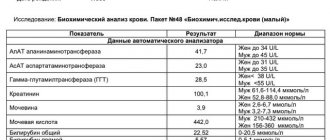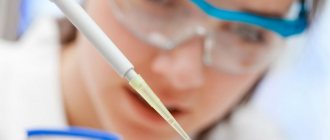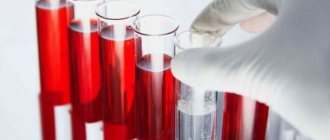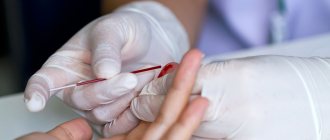Blood is the most important matter of the body, performing regulatory, nutritional, excretory, respiratory and other functions.
50% of blood consists of plasma. This is a multicomponent liquid that includes trace elements, enzymes and hormones. The other 50% belongs to blood cells, each of which has its own unique role.
Any disease, be it inflammatory, oncological, autoimmune or metabolic, affects the qualitative and quantitative composition of the blood. And therefore, the diagnosis of diseases begins with the appointment of a general blood test.
Definition and Purposes of Purpose
CBC (complete blood count) is a laboratory diagnostic method for assessing the condition of the body and searching for the source of pathology. This test can be prescribed by a doctor of any specialty. In what cases is OAC prescribed:
- For prevention during medical examinations. The composition of the blood is relatively constant and rarely goes beyond the normal range in a healthy person. And some diseases may not affect your well-being for a long time, and then a preventive test will become a reason for subsequent examination.
- When the first symptoms of illness appear. Analysis in this case can make it possible to determine the nature of the disease, the degree of intensity of inflammation or an allergic reaction.
- OAC may be re-prescribed to monitor the course of the disease over time. Also to assess the effectiveness of the therapy.
What indicators are included in the UAC?
The general blood test includes the following indicators: red blood cells, hemoglobin, leukocytes, color index, hematocrit, reticulocytes, platelets, ESR.
The leukocyte formula in some laboratories is signed by default, in some a doctor’s note is required. It includes the following indicators: eosinophils, basophils, band and segmented neutrophils, lymphocytes, monocytes.
Below is a table of norms for a general blood test:
| Index | Laboratory designation | Norma (women) | Norma (men) | Unit |
| Red blood cells | R.B.C. | 3,8-4,5 | 4,4-5,0 | 1012/l |
| Hemoglobin | HGB | 120-140 | 130-160 | g/l |
| Leukocytes | WBC | 4,0-9,0 | 4,0-9,0 | 109/l |
| Color index | CPU | 0,8-1,0 | 0,8-1,0 | |
| Hematocrit | HCT | 35-45 | 39-49 | % |
| Reticulocytes | RET | 0,2-1,2 | 0,2-1,2 | % |
| Platelets | PLT | 170,0-320,0 | 180,0-320,0 | 109/l |
| ESR | ESR | 2-15 | 1-10 | mm/hour |
| Leukocyte formula: | ||||
| Basophils | BAS | 0-1 | 0-1 | % |
| Eosinophils | EO | 0,5-5 | 0,5-5 | % |
| Myelocytes | 0 | 0 | % | |
| Metamyelocytes | 0 | 0 | % | |
| Band neutrophils | NEUT | 1-6 | 1-6 | % |
| Segmented neutrophils | NEUT | 47-67 | 47-67 | % |
| Lymphocytes | LYM | 18-40 | 18-40 | % |
| Monocytes | MON | 3-11 | 3-11 | % |
At some points, the standard blood test for adults differs from that for children.
For example, the norm of hemoglobin in a child is 110-145 g/l, leukocytes 5.0-12.0 109/l, the content of lymphocytes can be in the range of 26-60%. The remaining blood test parameters correspond to the reference values for adults.
By order of the Ministry of Health, in the first year of life, a child’s blood is taken for general analysis 4 times, then at 1 year 6 months, and then annually, starting from two years. Such measures are necessary for the early detection of blood diseases, anemia, and infections.
Hemoglobin in the general blood test (HGB, Hb)
The gas exchange function is carried out due to the presence of red blood cells containing hemoglobin. It is a complex protein consisting of ionized iron (heme) and four globular proteins (globin). It is in this combination that Hb is able to bind to oxygen in the lungs and transport it to the tissues. In the opposite direction, hydrogen protons are added, which is important in maintaining the pH (acidity) of the blood and a small amount of carbon dioxide (about 5%). Transport of most CO2 (approximately 95%) occurs by dissolution and chemical transformation in plasma.
This study is of great value for diagnosing various pathological conditions. The norm for men is 130-160 g/l, for women – 120-140 g/l. More often there is a decrease in the indicator, which may be a manifestation of:
- Deficiency of the main components - iron, vitamin B12, folic acid. The deficiency occurs due to their limited intake from food, the pathology of the absorption of nutrients in the intestines, the greater needs of the body during pregnancy, during periods of active growth and with constant physical activity;
- Acute or chronic blood loss;
- undergone surgery;
- Recovery period after severe infections;
- Taking antibacterial drugs, chemotherapy;
- Pathologies of red bone marrow and liver;
- Erythropathies with a change in shape, decreased elasticity and, as a result, increased breakdown of these cells (hemolysis) with the destruction of the hemoglobin protein they contain.
Low HGB is manifested by pale skin (jaundice in hemolytic anemia), weakness, disruption of the heart and other internal organs, especially the central nervous system, which is most sensitive to hypoxia.
The increase in concentration is a consequence of:
- Dehydration;
- Hypoxia (with cardiovascular, pulmonary diseases, living in high mountains, smoking);
- Work in conditions with reduced oxygen content (mines, foundries, rooms with poor ventilation, high levels of carbon monoxide);
- Tumors of the kidneys and red bone marrow with damage to the sprouts of erythrocyte hematopoiesis;
- Increased secretion of androgens and corticosteroids.
There are no specific symptoms of hyperhemoglobinemia, but there may be hyperemia of the skin, increased blood pressure, heaviness in the left hypochondrium in the area of the spleen and a tendency to thrombus formation.
For timely diagnosis, a general analysis must be performed at the first symptoms, as well as for preventive purposes at least once a year.
Interpretation of a general blood test
Below are the most basic indicators of the KBC, their functions in the body, and the reasons for deviations upward or downward.
Red blood cells
These are small elastic cells containing hemoglobin in their cytoplasm. Due to their elasticity, they easily pass through vessels of any caliber. They are produced in the bone marrow, the viability of one cell is about 3-4 months.
Red blood cells perform the following function: they carry oxygen from the lungs to all human tissues and organs, and on the way back from the tissues to the lungs they bring carbon dioxide. All this happens by adding gases to the hemoglobin of the red blood cell.
The norm of red blood cells when deciphering tests is on average from 3.8 to 5.0 1012/l
- An increase in red blood cells in a general blood test is possible with dehydration due to vomiting and diarrhea, diseases of the blood system (erythremia, Vaquez disease), cardiac and respiratory failure.
- their reduction can occur with blood loss, leukemia and lymphomas, congenital hematopoietic defects, hemolytic anemia, oncology, insufficient intake of protein, iron and vitamins.
It should be remembered that the norm of red blood cells, as well as other indicators, may differ in different laboratories. In which, moreover, errors are not excluded. Therefore, a borderline result does not always indicate a serious illness.
Hemoglobin
Hemoglobin is an iron-containing protein found in red blood cells. It is due to this that the function of gas exchange between the lung tissue and all cells of the body is performed. A deviation in hemoglobin levels from the norm can cause a person to feel unwell, weak, and easily fatigued. This is due to a lack of oxygen in organs, including the brain.
The normal hemoglobin content in a general blood test is on average 120-160 g/l, depending on the gender and age of the subject.
- An increase in hemoglobin can occur due to dehydration due to diabetes mellitus, vomiting and diarrhea, due to heart failure, overdose of diuretics, pulmonary failure, heart defects, diseases of the blood and urinary system.
- A decrease in hemoglobin in a general blood test is possible with anemia of various origins and other blood diseases, blood loss, insufficient intake of protein, vitamins, and iron
Leukocytes
These are white blood cells synthesized in the bone marrow. They perform the most important defense function in the body, aimed at foreign objects, infections, and foreign protein molecules. They are also able to dissolve damaged body tissue, which is one of the stages of inflammation. The viability of these cells varies from several hours to several years.
The norm of leukocytes in a general blood test corresponds to 4.0-9.0 109/l.
- An increase in leukocytes in the CBC is possible due to physiological errors (pregnancy, donating blood after meals, heavy physical activity, after vaccinations), inflammatory processes of a systemic or local nature, extensive injuries and burns, active autoimmune diseases, in the postoperative period, with oncology, leukemias and leukemias.
- If, when reading a blood test, leukocytes are reduced, the presence of viral infections, systemic autoimmune diseases, leukemia, radiation sickness, and hypovitaminosis is acceptable. Taking cytostatics and steroids may also affect this.
Color index
The color index (CI) is determined by a calculation method using a special formula. It shows the average concentration of hemoglobin protein (Hb) in one red blood cell.
Normally, the CPU is 0.8-1.0, without units of measurement.
- Its increase may indicate the presence of hyperchromic anemia (vitamin D deficiency).
- A decrease is possible in iron deficiency anemia, posthemorrhagic anemia, leukemia and lymphoma, and chronic organ diseases.
Hematocrit
This is an indicator reflecting the ratio of blood cells (leukocytes, erythrocytes, platelets) to the total blood volume. The analysis is carried out by centrifugation or using analyzers.
Normally, the hematocrit is on average 35-50%.
- An increase may indicate erythremia, respiratory failure, heart failure, dehydration due to diabetes mellitus and diabetes insipidus, diarrhea and vomiting.
- A decrease in hematocrit may be due to anemia, erythrocytopenia, renal failure, pregnancy (third trimester).
Reticulocytes
These are the precursors of red blood cells, their intermediate form. They perform the function of gas exchange, just like red blood cells, but with less efficiency. In a healthy person, reticulocytes, when deciphered, make up 0.2-1.2% of the total number of red blood cells.
- They may be increased during post-hemorrhagic restoration of hematopoiesis, when moving to a mountainous area or when treating anemia.
- Reticulocytes in the general blood test decrease with reticulocytopenia (slow hematopoiesis in the bone marrow, leading to anemia).
Platelets
These are small, flat blood cells that have no color. They perform several important functions - they participate in blood clotting, form platelet thrombus, regulate the tone of the vascular wall, and nourish capillaries.
In a general blood test, the normal platelet count is 180-320 109/l.
- An increase in platelets when deciphering the analysis is possible during splenectomy (removal of the spleen), exacerbation of chronic autoimmune diseases, anemia of various origins, inflammatory processes, in the postoperative period, the third trimester of pregnancy, in oncology, erythremia.
- Platelets in the CBC decrease in hemophilia, drug-induced thrombocytopenia, systemic lupus erythematosus, viral and bacterial infections, aplastic anemia, Evans syndrome, autoimmune thrombocytopenic purpura, and renal vein thrombosis.
ESR
Erythrocyte sedimentation rate (ESR) is an indicator calculated during a laboratory test. Under the influence of anticoagulants, the erythrocyte sedimentation time is calculated, which depends on the protein composition of the plasma.
This is a highly sensitive indicator; normally it averages from 1 to 15 mm per hour.
- It increases during physiological conditions (pregnancy, menstruation), during infectious diseases, malignant neoplasms, systemic autoimmune diseases, kidney diseases, in the postoperative period, during injuries and burns.
- Decreased in astheno-neurotic syndrome, recovery from infection, cachexia, long-term use of glucocorticoids, blood clotting disorders, high concentrations of glucose in the blood, traumatic brain injury, use of NSAIDs, immunosuppressants, antibiotics.
Neutrophils
This is the largest subtype of leukocytes, which, depending on the maturity of the cells, is divided into the following groups - young neutrophils, band neutrophils and segmented neutrophils.
They perform an antimicrobial function, are capable of phagocytosis, and participate in the inflammatory response.
The normal range of neutrophils in a blood test is band 1-6%, segmented 47-67%.
- An increase in neutrophils when decoding a blood test is possible under physiological conditions (sun and temperature exposure, stress, pain, etc.), previous infections, bone marrow diseases, oncology, taking certain medications, ketoacidosis, poisoning with poisons and alcohol, and parasitosis , allergies, hyperglycemia.
- They decrease in the state after chemotherapy, with HIV/AIDS, aplastic anemia, long-term infectious disease, exposure to radiation, deficiency of vitamin B12 and folic acid.
Lymphocytes
This is also a subtype of leukocytes, presented in the form of T lymphocytes, B lymphocytes, K and NK lymphocytes.
All of them participate in acquired immunity, synthesize antibodies, destroy not only foreign, but also their own pathological cells (oncological).
The norm of lymphocytes when deciphered in the CBC is 18-40%
- An increase in the general blood test can occur with viral infections (mononucleosis, viral hepatitis and others), toxoplamosis, blood diseases (chronic and acute lymphocytic leukemia, lymphoma, leukemia), with arsenic, lead poisoning, taking levodopa, narcotic painkillers.
- Lymphocytes decrease in tuberculosis, HIV, blood diseases (lymphogranulomatosis, aplastic anemia), end-stage renal failure, cancer in the terminal stage and during treatment with radiotherapy and chemotherapy, taking glucocorticoids.
Monocytes
This is a type of the largest leukocytes, also synthesized in the bone marrow. They are able to phagocytose (absorb) viruses, bacteria, tumor and parasitic cells. Regulate hematopoietic function and participate in blood clotting.
The normal blood test for monocyte content is 3-11%.
- an increase in monocytes when deciphered indicates viral, bacterial (tuberculosis, syphilis, brucellosis), fungal and parasitic infections, inflammation in the regeneration stage, systemic autoimmune diseases (systemic lupus erythematosus, rheumatoid arthritis), leukemia.
- a decrease in monocytes in a blood test is possible during purulent-inflammatory processes, aplastic anemia, in the postoperative or postpartum period, and when taking steroids.
How to decipher the leukocyte formula?
Leukocyte formula, microscopy of leukocytes, five fractions of leukocytes, differentiation of leukocytes - in doctor’s prescriptions you can find many names for the same thing. Where can I find it and how to decrypt it?
What are leukocytes?
Leukocytes (white blood cells) are a large group of blood cells. Their main purpose is to protect the body from infections. All leukocytes are part of the immune system; they are involved in allergic, autoimmune, and tumor processes. Each type of white blood cell has its own role and is important for the body.
A general blood test without a leukocyte formula speaks only about the total content of leukocytes and does not reveal what type of leukocytes is responsible for the increase (leukocytosis) or decrease (leukopenia) of white blood cells. The leukocyte formula determines five types of leukocytes and is assessed in a comprehensive general blood test. To decipher the leukocyte formula, you need to evaluate the content of each type of leukocyte and their ratio to each other.
The leukocyte formula is calculated by an automatic blood analyzer. Taking the content of all white blood cells as 100%, it gives the percentage (%) of each type of white blood cell. It also automatically measures their content in blood volume (per liter). Sometimes a “hand count” and visual assessment of the blood smear under a microscope is required. For example, when the white blood cell count is altered, there are strange or immature cells, there are signs of anemia or a decrease in platelets in the general blood test. In this case, you can only see the percentage of the leukocyte formula.
Granulocytes - shock forces
The largest part of leukocytes is represented by granulocyte cells. They got their name due to the presence of inclusions (granules). The granules contain immune chemicals. In the leukocyte formula you can see three types of granulocytes: neutrophils, eosinophils, basophils. They differ in the structural features of the core and the coloring of the granules with different dyes. Granulocytes are important in the development of inflammation and immune defense of the body. They are capable of absorbing and digesting proteins and chemicals. All granulocytes mature in the bone marrow, maintaining a supply of mature cells there for 3-4 days. Granulocytes circulate in the blood for no more than 6 hours, moving into the tissues where they perform their function.
Neutrophils make up the largest number of leukocytes circulating in the blood. Every day, 1010 neutrophils enter the bloodstream. Neutrophilia (an increase in the number of neutrophils in the blood) is an indicator of a bacterial infection. The more severe the infection, the more neutrophils come out to fight. Due to their low life expectancy (about 4 days), younger, immature forms of cells (band cells, metamyelocytes, and others) begin to enter the blood. Doctors call this a “leukocyte shift to the left.” When there are very few neutrophils in the blood (neutropenia), the body is not protected from infections.
Eosinophils in the blood make up no more than 5% of the total number of leukocytes. Their concentration fluctuates throughout the day due to the influence of adrenal hormones. In the morning it is maximum. They accumulate in the submucosal layer of the gastrointestinal tract. Eosinophilia (increased eosinophilia in the blood) occurs with parasitic infections, allergic and autoimmune processes.
Basophils make up the smallest number of leukocytes in the blood (less than 1%) and are involved in allergic reactions by releasing histamine. This substance is responsible for bronchospasm, itching, swelling, and redness. Depending on where the basophils get to, there will be manifestations of allergic reactions: an attack of bronchial asthma, skin rash, urticaria, Quincke's edema (swelling of the larynx).
Monocytes are tissue hunters
The second link of leukocytes is monocytes. In the bone marrow, having formed in 5 days, they do not form a reserve. In the blood, monocytes make up about 10% of the mass of leukocytes, quickly disappearing into the tissues. Tissue macrophages, and this is what monocytes will be called, are mainly found in the liver, spleen, and lungs. Their life expectancy is very long (60 days). They are the main hunters of the immune system, because... absorb and process thousands of foreign proteins, turning them into antigens accessible to immune cells.
Monocytosis (an increase in monocytes in the blood) is associated with chronic infections, as well as with infections whose pathogens are hidden in the body’s cells (viruses, chlamydia, mycoplasma).
Lymphocytes are reliable defenders
Antigens processed by monocytes-macrophages and other immune cells attract lymphocytes. Lymphocytes provide acquired immunity by producing antibodies and memory cells to protect against re-infection.
Lymphocytes are formed in the bone marrow and circulate both in the blood and in the lymphatic system. Important organs of cell maturation are the thymus (thymus gland) and lymph nodes. Lymphocytes perform various immune functions, representing the second largest group of leukocytes. There is a special blood test (immunophenotyping) that allows you to identify different types of lymphocytes. This can be important for diseases of the immune system, HIV infection, etc.
In the leukocyte formula, both an increase in lymphocytes (lymphocytosis) - more typical for viral infections - and lymphopenia (a decrease in their number) are important. A lack of lymphocytes reduces the body's defenses and is observed in immunodeficiencies (including HIV infection).
In the Lab4U laboratory you can take the following tests with a 50% discount:
- General blood test with leukocyte formula (automatic counting)
- General blood test with microscopy (manual leukocyte count)









